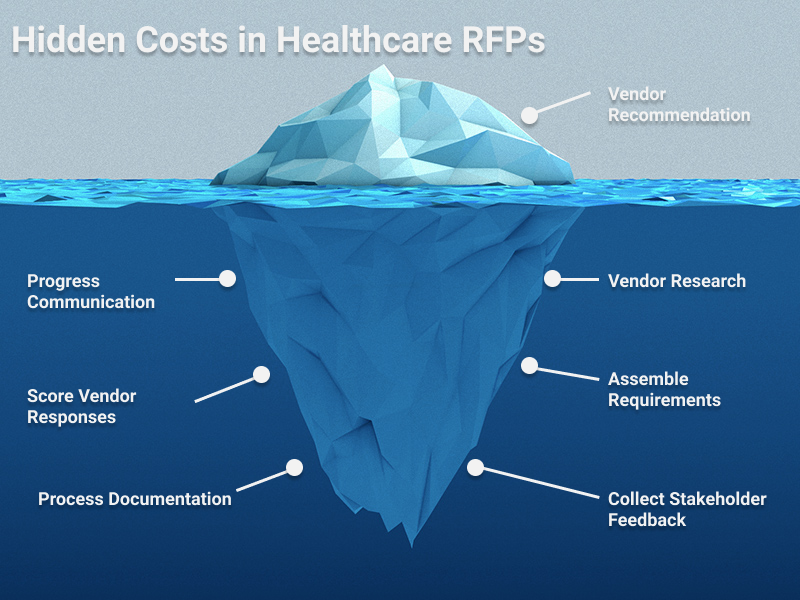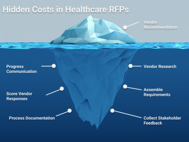Healthcare is notorious for long, crawling purchase cycles, and no process better demonstrates that than an “RFP.” Used to compare and evaluate vendor products and services, this approach was once the gold standard for vendor diligence, but it has come at a price, specifically limiting organizations’ ability to innovate and see faster returns on their purchases.
Speed Up Your RFP Process to Deliver a Solution More Rapidly
Most organizations use a Request for Proposal (RFP) as part of a selection process to solicit vendors for products or services. Historically, this questionnaire format helped organizations manage the complexity of the products evaluated, ensure that a vendor can fulfill its promises, and document the diligence necessary to purchase goods and services. To assemble an RFP the needs from various departments are included as requirements, usually compiled in a spreadsheet, and are sent to vendors to respond. Vendors document their capability to meet those requirements, from which a project owner or selection committee selects the best vendor for their needs.
Administering an RFP can be a titanic effort. For certain products or services, some healthcare organizations dedicate 20-person teams to vendor selections because of the volume of data and interactions required. Often hundreds of requirements are collected, dozens of vendors solicited for responses, and thousands of individual scores are calculated among many stakeholders. A recent care coordination project evaluated 50 vendors, and another customer required an 80-question survey as a prerequisite to participating in the RFP!
Keep Everyone in Sync with Less Involvement
How do organizations manage this volume of information? Not easily. This work sprawls across in-person meetings, inboxes, spreadsheets, and documents. Project owners copy/paste from one document to the next or one email to another just to keep vendors and project stakeholders in sync.
As described by one healthcare supply chain professional, “We copy requirements into a single document. We send that document to all participating vendors. We copy their responses into a new document. We send that document to stakeholders, who annotate and score the information. We then copy their information into a single document to review results. After that, we copy results into vendor-specific versions to record their performance in the RFP.”
Your Healthcare RFP May be Out of Date Before You Get a Response
The result of this arduous and time consuming process is that a typical vendor selection ranges between 9-18 months, depending on the scope of the project and number of stakeholders.
As you see, despite its rigor, an RFP can also dramatically slow a purchase. Keep in mind that healthcare organization’s aren’t making a lot of optional purchases; more often, solutions are evaluated to solve immediate needs with financial, operational, and clinical consequences. An RFP delays remedying the problem. A 9-18 month sales cycle means that an organization cannot implement a solution until years after the need has been identified, where the expected benefits are shackled to a process incapable of moving as quickly as business needs.
Healthcare RFPs Involve a Lot of Time and Manual Effort
Further, this manual-intensive approach limits the number of improvements an organization can tackle without adding more personnel. Highly qualified (and expensive) staff are often reduced to versioning documents, corralling participants, and copy/pasting thousands of spreadsheet cells. Organizations can invest in consulting services to shepherd purchase projects at a price. Most organizations cannot afford to increase staff or hire consultants to manage purchase decisions and ultimately address fewer needs.
These time and resource costs dramatically extend the time for organizations to realize a return from their purchases. Organizations must include vendor diligence as part of their ROI calculus, as team resources are deployed to identify, evaluate, and select a solution. A product expected to deliver a financial return after two years following a 12-month sales cycle should be evaluated as at least a three-year ROI (2-year expected after implementation + 1-year sales cycle) and the resource costs incurred to select a vendor. The true purchase cost balloons when considering multiple stakeholders’ time over several months.

There’s a Better Way to Handle Your Healthcare RFP Process
RFPs afford organizations a systematic way to perform vendor diligence, justify a purchase, and ensure all market factors and cost models have been taken into consideration. At its worst, RFPs can be a painstaking process that presents delays and roadblocks to a needed product or service; but at its best, RFPs can ensure the best contract terms for your organization, and lock in pricing, terms, and conditions that will reduce costs, improve service quality, and better meet stakeholder’s expectations.
Read more about creating quality RFPs that will expedite vendor selection and will lock in savings. And try out the Valify Marketplace for our vendor search tools and Request For Information (RFI) / RFP tools.

